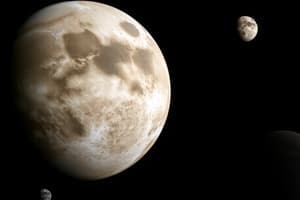Podcast
Questions and Answers
Who became the first American woman in space in 1983?
Who became the first American woman in space in 1983?
When did NASA finally send its first female astronaut, Dr. Kate Rubins, to space?
When did NASA finally send its first female astronaut, Dr. Kate Rubins, to space?
What event marked the roots of the space race between the United States and the Soviet Union?
What event marked the roots of the space race between the United States and the Soviet Union?
In what year did the Mercury 13 program take place?
In what year did the Mercury 13 program take place?
Signup and view all the answers
What did the Mercury 13 program reveal about gender discrimination in space exploration?
What did the Mercury 13 program reveal about gender discrimination in space exploration?
Signup and view all the answers
What did the Mercury 13 program demonstrate about the women who participated?
What did the Mercury 13 program demonstrate about the women who participated?
Signup and view all the answers
What was one of the main reasons NASA gave for not allowing women to train and fly in space during the space race?
What was one of the main reasons NASA gave for not allowing women to train and fly in space during the space race?
Signup and view all the answers
What did the women who completed the Mercury 13 program prove with their performance?
What did the women who completed the Mercury 13 program prove with their performance?
Signup and view all the answers
Why did NASA refuse to allow the women of the Mercury 13 program to officially train and fly in space?
Why did NASA refuse to allow the women of the Mercury 13 program to officially train and fly in space?
Signup and view all the answers
What was one of the main themes highlighted by Tanya Lee Stone's book 'Almost Astronauts: 13 Women Who Dared to Dream'?
What was one of the main themes highlighted by Tanya Lee Stone's book 'Almost Astronauts: 13 Women Who Dared to Dream'?
Signup and view all the answers
Study Notes
Mercury 13 and NASA's UnRealized Opportunities
In the midst of the space race, a group of women defied the odds and pushed boundaries, their stories remaining largely untold until Tanya Lee Stone's poignant book "Almost Astronauts: 13 Women Who Dared to Dream" brought their inspiring tales to light. This narrative delves into the lesser-known history of the Mercury 13 program, revealing the profound gender discrimination that clouded women's participation in NASA's space exploration during the 1960s.
The Mercury 13 Program
In 1960, a group of 13 women underwent rigorous testing to qualify as astronauts, equal in skill to their male counterparts. The Mercury 13 program, conducted by Dr. William Randolph Lovelace II, demonstrated that these women met the same physical and psychological standards as the male astronauts selected for NASA's Mercury program. However, NASA refused to allow these women to officially train and fly in space due to their gender.
Gender Discrimination
Women's roles during the space race were limited to supporting roles, while men were the ones who took to the stars. NASA justified this by claiming that women were biologically unsuitable for space travel, citing "gender-specific" reasons for excluding them from spaceflight. However, the women who completed the Mercury 13 program proved that these claims were groundless, as the women passed the same tests and exhibited the same fitness levels as male astronauts.
Women in Space Exploration
Despite the apparent success of the Mercury 13 program, NASA remained unwilling to consider women for spaceflight until decades later. Sally Ride became the first American woman in space in 1983, and it took until 2001 for the first woman (Natalia Kolesnikova) to fly in a Russian spacecraft. It wasn't until 2012, more than half a century after the Mercury 13 program, that NASA sent its first female astronaut, Dr. Kate Rubins, to space.
Space Race and NASA History
The space race, an intense period of rivalry between the United States and the Soviet Union, had its roots in the Cold War and the U.S. desire to demonstrate technological superiority. The Mercury 13 program occurred during the space race, and while it revealed the gender discrimination that persisted throughout the time, it also underscored the U.S.'s reluctance to embrace equality, highlighting the limitations of the space race's focus on technological achievement.
In conclusion, "Almost Astronauts" provides a window into NASA's history, revealing a pivotal moment when women were excluded from spaceflight based solely on their gender. The stories of these 13 brave women demonstrate that their potential was overlooked, and, in the process, it highlights the need to embrace equality. Their perseverance and courage in the face of adversity ultimately paved the way for future generations of women in space exploration.
Studying That Suits You
Use AI to generate personalized quizzes and flashcards to suit your learning preferences.
Description
Explore the history of the Mercury 13 program, a group of women who underwent testing to become astronauts during the 1960s but were ultimately denied the chance to fly in space due to gender discrimination. Learn about the challenges faced by these pioneering women and their impact on the space exploration narrative.




